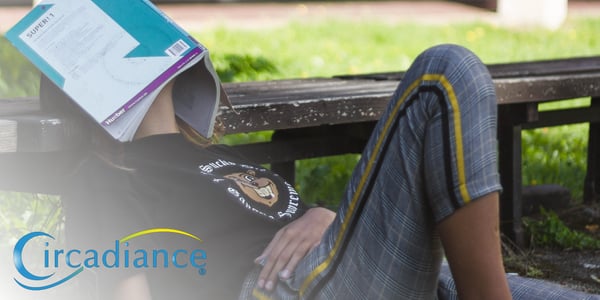 David Letterman’s ‘Top Ten List’ was a comedy mainstay in my household growing up. But The Late Show aired too late so I watched the VCR recordings the next day. Dave’s humorous review of the topic of the day in a countdown has always been a format for maximum impact. 10 has just the right amount of depth and conciseness although the round numbered list has been around for some time (i.e., The Ten Commandments). I would, however, argue that Dave made the Top Ten List what it is today in our modern lexicon. You can not go anywhere without encountering a top ten from recipes on YouTube to football power rankings. Maybe it’s because they’re so easy to write—anyone can come up with one.
David Letterman’s ‘Top Ten List’ was a comedy mainstay in my household growing up. But The Late Show aired too late so I watched the VCR recordings the next day. Dave’s humorous review of the topic of the day in a countdown has always been a format for maximum impact. 10 has just the right amount of depth and conciseness although the round numbered list has been around for some time (i.e., The Ten Commandments). I would, however, argue that Dave made the Top Ten List what it is today in our modern lexicon. You can not go anywhere without encountering a top ten from recipes on YouTube to football power rankings. Maybe it’s because they’re so easy to write—anyone can come up with one.
As a Sleep Technologist, I have been observing Sleep, literally, for twenty years. The thing I am struck with is that in a world that takes place for third of our lives (25+ years out of a typical lifetime), most people have very limited understanding of why we do it or how important sleep is to our waking lives.
William Golding once said, "Sleep is when all the unsorted stuff comes flying out as from a dustbin upset in a high wind." Golding got it right with this insight where many others have had a misguided view of the complex nature of Sleep. To this day, I am surprised by how many see it as a period when the brain and body shut down when we now know that sleep is very much a psychologically and physiologically active time. This brings us to our first sleep myth, or rather, here is our top ten list of surprising sleep myths, debunked… nnnnnuumber ten!
10. Sleep is a quiet time.
Homer got it wrong when he wrote in the Iliad, Sleep and Death: who are twin brothers. But he was not alone in thinking that sleep is a state that shares similarity with “the ultimate slumber.” During the first half of the night, your body gets to work repairing muscle, ligament and bone damage during the day, and lowering your core temperature. During the second half of the night, the brain focuses on learning and the consolidation of memories through dream rehearsal.
9. You can ‘cheat’ sleep.
Sleep serves to keep the brain and body in a state of balance; and it affects everything from memory consolidation and body temperature regulation to mood and concentration, cardiac function and insulin sensitivity.
The more significant misconceptions is that it’s achievable and even a sign of strength to cheat sleep. I call this the "I’ll sleep when I’m dead" theory. There was a commercial for the Olympics some time ago with a young athlete meant to represent the next generation of Olympic heroes. She was shown waking up to train while the window of her room was still dark and the clock next to the bed read 5 am!
In 2015, a panel of sleep experts convened a position statement on how much sleep is needed.¹ They pored through thousands of scientific articles and came up with a recommendation of 7 or more hours. The conclusion is significant because in the 50 year history of sleep science, no one had undertaken a project to answer this basic question.
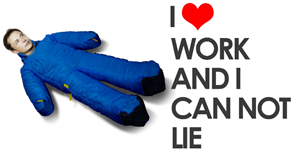 There are people who claim they’re ‘just fine’ on 4 hours sleep, thank you very much. Elon Musk, Tyler Perry, Will Smith, Martha Stewart, Jay Leno and Arnold Schwarzenegger all claim to belong to the ‘4 hour club.’ But for very few is this true. ‘Short sleepers,’ as they are called in the clinical literature, can function on 6 hours or less but they are few and far between: scientists have discovered a gene unique to ‘short sleepers’ that may explain their ability to get by on less, however this gene is only found in 2-3% of the population.
There are people who claim they’re ‘just fine’ on 4 hours sleep, thank you very much. Elon Musk, Tyler Perry, Will Smith, Martha Stewart, Jay Leno and Arnold Schwarzenegger all claim to belong to the ‘4 hour club.’ But for very few is this true. ‘Short sleepers,’ as they are called in the clinical literature, can function on 6 hours or less but they are few and far between: scientists have discovered a gene unique to ‘short sleepers’ that may explain their ability to get by on less, however this gene is only found in 2-3% of the population.
The rest of us need on average between 7 or more each night to stay fit, healthy and alert during the day. Not getting this amount risks physical health and impairs cognitive performance, leading to an increase in the likelihood of accidents and loss of productivity, which can have widespread indirect effects on the community at large.²
8. Sleep disorders are rare, and only men get sleep apnea.
After pain, sleeplessness is the most common complaint in the primary care setting. 50 million Americans are estimated to suffer from chronic pain. But even more (70 million) have symptoms of Insomnia, while 54 million are estimated to suffer from OSA according to a Lancet article from 2019 on global prevalence—the second highest number in the world (after China, estimated to have 176 million cases).³
The average patient age at most sleep labs is in the 50’s. The reason? It isn’t until the sixth decade that people start to see the impact of sleep problems on their health, and start to take action. The saying that people see the light only when they feel the heat is true for chronic healthcare change. Also, after 50 or menopause, women catch up to men in sleep apnea severity.
7. If you don’t sleep during the week, just catch up on the weekend.
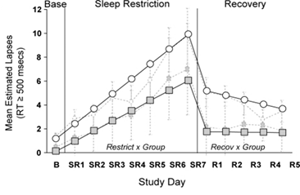 Sleep deprivation has been studied in great detail and one of the most relevant models of its accumulated loss as a ‘sleep debt’.⁴ Think of sleep as a bank account, every hour of lost sleep incurs a deficit, adding to your cumulative ‘sleep debt.’ As this debt is increased, for example with consecutive nights without adequate sleep, according to the theory you can expect a likewise increase in health and cognitive performance deficits. This is demonstrated in this graph of study subjects who were deprived of sleep for seven nights and tested for performance lapses each day.⁵ The first group (represented with ‘circles’), prepared for the study with normal sleep. The second group (represented with ‘squares’), had been ‘banking’ or oversleeping before the start of the study. Both groups experienced decrements in performance as measured in lapses on a performance task called the Psychomotor Vigilance Task (PVT), though the ‘bankers’ did show less performance decrement. The striking thing is that even after five nights over ‘recovery’ sleep to catch up on missed slumber, both groups continued to perform worse than baseline. This suggests that the physiological mechanisms underlying chronic sleep debt undergo long-term (i.e., days/weeks) changes after repeated nights of sub-optimal sleep. And that is not something you can ‘catch up on’ over a weekend.
Sleep deprivation has been studied in great detail and one of the most relevant models of its accumulated loss as a ‘sleep debt’.⁴ Think of sleep as a bank account, every hour of lost sleep incurs a deficit, adding to your cumulative ‘sleep debt.’ As this debt is increased, for example with consecutive nights without adequate sleep, according to the theory you can expect a likewise increase in health and cognitive performance deficits. This is demonstrated in this graph of study subjects who were deprived of sleep for seven nights and tested for performance lapses each day.⁵ The first group (represented with ‘circles’), prepared for the study with normal sleep. The second group (represented with ‘squares’), had been ‘banking’ or oversleeping before the start of the study. Both groups experienced decrements in performance as measured in lapses on a performance task called the Psychomotor Vigilance Task (PVT), though the ‘bankers’ did show less performance decrement. The striking thing is that even after five nights over ‘recovery’ sleep to catch up on missed slumber, both groups continued to perform worse than baseline. This suggests that the physiological mechanisms underlying chronic sleep debt undergo long-term (i.e., days/weeks) changes after repeated nights of sub-optimal sleep. And that is not something you can ‘catch up on’ over a weekend.
6. Snoring is harmless.
The sound of snoring has been the object of many a caricature over the years, and is surprisingly still considered a benign if not comedic part of being human. The first known humorous description in the English literature came in 1836 from the author of Great Expectations, A Christmas Carol and Oliver Twist. Charles Dickens wrote his first novel about the humorous adventures of Samuel Pickwick and his companions throughout the English countryside, including a character known only as ‘Joe the fat boy,’ in the Pickwick Papers.
Ask any sleep professional and she’ll tell you: not everyone who snores has obstructive sleep apnea (OSA), but everyone with obstructive sleep apnea snores! As a 20-year sleep technologist, I heard my share of snorers, and I see it differently. The sound of snoring is usually associated with breathing pauses or partial obstructions in breathing, called hypopneas (derived from the Ancient Greek hupo- “under” + -pnoē “breathing”). So snoring is an obstructive breathing event that can have clinical implications. It is associated with OSA but can occur independently as a result of airway vibrations that typically range from 60 to 80 decibels in intensity. As a point of reference, a vacuum cleaner typically emits a decibel level of 70 and a chainsaw, 100. Hearing damage can result from prolonged exposures greater than 80 decibels. A grandmother of 4 in the U.K. was recently recorded with a snoring level of 111.6 decibels!⁶ Snoring can be a sign of a serious sleep disorder like sleep apnea which is associated with a host of increased health risks including obesity, diabetes, high blood pressure, heart disease, stroke and more.⁶ In addition, a limited number of long-term follow-up studies have found increased mortality in patients with OSA who are not treated.⁶ Knowing what we now know about the associations to OSA, snoring is no laughing matter.
5. Never wake a sleepwalker.
This is one of the most commonly-recited myths about sleep, that somehow waking a sleepwalker would cause a shock so terrible as to lead to someone’s death! Sleepwalking is an arousal disorder that occurs during ‘non-dreaming’ or NREM sleep. All arousal disorders are very common and getting sufficient sleep often controls them, but when young people go through a period of sleepwalking, they can come roaring back in college when sleep typically becomes disrupted again. And no, there is not a single recorded case of this being fatal.
4. Turn up the radio and roll down the window to stay awake while driving.
We’ve all been there. You’re in the middle of a long trip on the verge of sleep, driving down a secluded stretch of highway at night, and you realize you’re not going to make it.
November 1-8, 2020 is Drowsy Driving Prevention Week, and not coincidentally it’s the first week after moving our clocks back by an hour. According to the National Sleep Foundation, about half of U.S. adult drivers admit to consistently getting behind the wheel while feeling drowsy. About 20% admit to falling asleep behind the wheel at some point in the past year – with more than 40% admitting this has happened at least once in their driving careers.
This was studied and both of these methods—plus each of these other commonly-cited, in-car alerting techniques—turning up the A/C; face slapping; talking; yelling; etc.—only get you about an extra five minutes each.
If you are nodding off behind the wheel, it has scientifically been shown that the best technique is to down a cup of coffee and take a nap for 20 minutes. By the time you wake up, the caffeine will have kicked in and you will be good to go!
3. Yawning is a sign of tiredness.
 There are three truisms about yawning that demonstrate it’s not just about alertness: a) yawning is curiously contagious, b) yawning has been found to play a role in cooling the brain, and c) yawning relieves ear pressure. For years, yawning got a bad rap for being a sign of sleepiness. Science is changing all that. A recent systematic review of the research on yawning found strong evidence that it serves a variety of physiological functions above and beyond alerting.⁷ For example, yawning tends to follow high levels of physical exertion and is thought to serve as a thermoregulating factor, lowering the temperature of the body. Look closely and you will sometimes see elite athletes yawning in the middle of competition—world #1 tennis star Novak Djokovic does it when returning serve. Another finding is that yawning helps equalize ear pressure at altitude, although swallowing can have the same effect. Finally is the social role for yawning. Highly empathetic people have been found to yawn more frequently compared to their less empathetic peers. Even dogs are susceptible to the contagion of yawning.
There are three truisms about yawning that demonstrate it’s not just about alertness: a) yawning is curiously contagious, b) yawning has been found to play a role in cooling the brain, and c) yawning relieves ear pressure. For years, yawning got a bad rap for being a sign of sleepiness. Science is changing all that. A recent systematic review of the research on yawning found strong evidence that it serves a variety of physiological functions above and beyond alerting.⁷ For example, yawning tends to follow high levels of physical exertion and is thought to serve as a thermoregulating factor, lowering the temperature of the body. Look closely and you will sometimes see elite athletes yawning in the middle of competition—world #1 tennis star Novak Djokovic does it when returning serve. Another finding is that yawning helps equalize ear pressure at altitude, although swallowing can have the same effect. Finally is the social role for yawning. Highly empathetic people have been found to yawn more frequently compared to their less empathetic peers. Even dogs are susceptible to the contagion of yawning.
2. Older people need less sleep.
Aging has predictable effects on sleep: less deep sleep, more disrupted sleep compared to those younger in age. But that doesn’t mean older adults sleep less. Professor Sean Drummond of the University of California clears up the misconception: Older adults benefit from getting as much sleep as they get when they were in their 30s. This varies from person to person but whatever you slept when you were 35 should be the same from 75. The problem is people find it harder to sleep as they get older and they think that that is a sign that they need less sleep but that is not the case.⁸
1. Teenagers are naturally lazy, and young children without a good night’s sleep are destined to be sleepy at school.
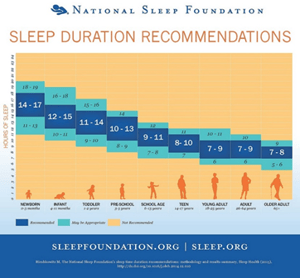 There are misconceptions about young people’s sleep as well. According to the National Sleep Foundation, school age children need between 9-11 hours sleep daily, and teens can get by on 8-10. The assumption is that when school kids don’t get the recommended sleep, they will be dragging all day and begging to lay down. Counter-intuitively, children have the opposite behavior as adults when it comes to sleepiness: there is an effort to ‘self-stimulate’ by engaging in more activity and overcompensate for their feeling of sleepiness through hyper-activity, inattentiveness and impulsive behavior. The problem with this is that this ‘sleepy’ behavior mimics ADHD, a psychological disorder treated with medication, when the cause is really lack of sleep! Look deeper, and experts have found many children exhibiting Attention Deficit symptomology are actually not getting adequate sleep because of a sleep behavior or sleep apnea disorder. Often, the treatment of correcting the sleep quality through sleep hygiene improvements, sleep timing, or tonsil & adenoid removal will immediately ameliorate the hyperactive behavior.
There are misconceptions about young people’s sleep as well. According to the National Sleep Foundation, school age children need between 9-11 hours sleep daily, and teens can get by on 8-10. The assumption is that when school kids don’t get the recommended sleep, they will be dragging all day and begging to lay down. Counter-intuitively, children have the opposite behavior as adults when it comes to sleepiness: there is an effort to ‘self-stimulate’ by engaging in more activity and overcompensate for their feeling of sleepiness through hyper-activity, inattentiveness and impulsive behavior. The problem with this is that this ‘sleepy’ behavior mimics ADHD, a psychological disorder treated with medication, when the cause is really lack of sleep! Look deeper, and experts have found many children exhibiting Attention Deficit symptomology are actually not getting adequate sleep because of a sleep behavior or sleep apnea disorder. Often, the treatment of correcting the sleep quality through sleep hygiene improvements, sleep timing, or tonsil & adenoid removal will immediately ameliorate the hyperactive behavior.
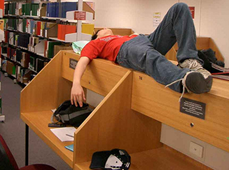 When it comes to teenagers, a completely different physiological process is at work. Teens typically start their day and are required to attend school earlier than school age kids. Meanwhile, the teenage drive to sleep is delayed by 2-3 hours due to a hormonal change that sees Melatonin being expressed later, which means the average teen doesn’t feel sleepy until 11:00pm or later—it’s not just texting that has this alerting affect! All of these transitions occur while still needing an elevated total amount of daily sleep of up to 10 hours. The math just doesn’t add up—no wonder teens roll over when it’s time to wake!
When it comes to teenagers, a completely different physiological process is at work. Teens typically start their day and are required to attend school earlier than school age kids. Meanwhile, the teenage drive to sleep is delayed by 2-3 hours due to a hormonal change that sees Melatonin being expressed later, which means the average teen doesn’t feel sleepy until 11:00pm or later—it’s not just texting that has this alerting affect! All of these transitions occur while still needing an elevated total amount of daily sleep of up to 10 hours. The math just doesn’t add up—no wonder teens roll over when it’s time to wake!
—Matthew Anastasi, BS RST RPSGT, Clinical Coordinator Consultant, Circadiance
REFERENCES
1. Watson NF, Badr MS, Belenky G, et al. Recommended Amount of Sleep for a Healthy Adult: A Joint Consensus Statement of the American Academy of Sleep Medicine and Sleep Research Society. Sleep. 2015;38(6):843-844. Published 2015 Jun 1. doi:10.5665/sleep.4716
2. CDC. Perceived insufficient rest or sleep among adults—United States, 2008. MMWR Morb Mortal Wkly Rep 2009; 58:1175–9
3. Benjafield AV, Ayas NT, Eastwood PR, et al. Estimation of the global prevalence and burden of obstructive sleep apnoea: a literature-based analysis. Lancet Respir Med. 2019;7(8):687-698. doi:10.1016/S2213-2600(19)30198-5
4. Kleitman N. Sleep and wakefulness. Chicago: University of Chicago Press; 1963.
5. Rupp TL, Wesensten NJ, Bliese PD, Balkin TJ. Banking sleep: realization of benefits during subsequent sleep restriction and recovery. Sleep. 2009;32(3):311-321. doi:10.1093/sleep/32.3.311
6. Anastasi MW. (2019, May). Chapter 46: Positive Airway Pressure Therapy: Basic Principles. In Lee-Chiong, TD, Mattice, C, Brooks, R (Eds.), Fundamentals of Sleep Technology 3rd (third) Edition. Philadelphia, PA: Lippincott Williams & Wilkins.
7. Gupta S, Mittal S. Yawning and its physiological significance. Int J Appl Basic Med Res. 2013;3(1):11-15. doi:10.4103/2229-516X.112230
8. Verilux. Sleep Myths, Debunked. Verilux. https://www.verilux.com/blogs/light-reading/sleep-myths-debunked. Accessed October 11, 2020.





